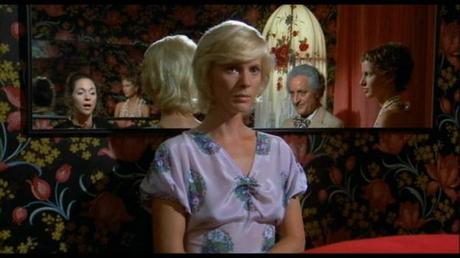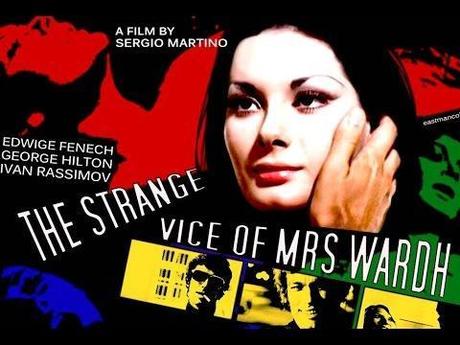When I think of giallo, Italy's legendary murder mystery/horror hybrid subgenre, I picture a "whodunit" narrative with an amateur detective protagonist following leads after witnessing a murder. There's probably a black-gloved killer, and we don't know who they really are until the very end. The journey getting there includes an overabundance of red herrings and Technicolor red blood. There's usually an almost purposefully confusing plot as well as an apartment you could get lost in and soundtrack you can't get out of your head. It's all so unmistakably Italian, drenched in Catholic guilt, usually directed by guys with names like Bava, Fulci and Argento, and sold with a wonderfully baroque title: The Girl Who Knew Too Much (1963). Blood and Black Lace (1964). The Bird with the Crystal Plumage (1970). Lizard in a Woman's Skin (1971). Deep Red (1975).
I don't, however, think of something like 1974's The Perfume of the Lady in Black. Turns out, maybe I should.

The directorial debut of actor-turned-writer-director Francesco Barilli, The Perfume of the Lady in Black initially seems to have far more in common with Roman Polanski's Repulsion and Rosemary's Baby than a standard giallo. Mimsy Farmer, an American actress who relocated to Italy, plays Silvia, an industrial scientist (though good luck ever picking up on that being her job) who suffers a series of hallucinations manifesting her repressed trauma. We think. It's not entirely clear what's actually going on, and - spoiler alert - the film never seems to offer a definitive explanation. Is Sylvia going crazy? Or being driven crazy by the people around her, including her boyfriend, his strange friends, and her suspicious neighbors? Or is it both?
Total Polanski, vibe, right? As the AV Club put it, like Repulsion and Rosemary's Baby this premises perfectly "emphasizes the heroine's terrifying isolation and the menacing encroachment of her neighbors."
But this setup, according to Arrow Video's companion novel Cult Cinema, is of a piece with the more female-centric giallos which took hold once the genre said goodbye to the 60s. In 1971, Sergio Martino's The Strange Vice of Mrs. Wardh looked at the usually male-driven body count thrillers of the day and took a "more languorous, psychologically-driven" approach centered on a mentally fragile women. A possibly disturbed American heiress living in Vienna (played by Edwige Fenech) is sent blackmail letters by an assassin who likely responsible for a series of murders in the city. The mystery forces the titular Mrs. Wardh to think back on her sadomasochistic love affairs all while carrying on a new affair with a mysterious suitor. Her husband, meanwhile, remains oblivious to it all. Or does he?

Vice's success led to imitation, as directors jumped at the chance to "craft narratives of their own about harangued, emotionally unstable female protagonists and their luridly violent mishaps." Martino himself made four more of these movies. Luciano Ercoli directed several of his own, all starring his wife, actress Nieves Navarro. The most notable of the bunch might be 1972's Death Walks at Midnight, in which a fashion model witnesses a murder while high on LSD and then struggles to convince anyone that what she saw was real.
The Perfume of the Lady in Black is of a piece with that movement, but not entirely identical to it. For example, there is no murder mystery to speak of here. This is instead a psychological breakdown thriller which quite often bends reality and possibly introduces supernatural elements. Her relationship with a rather brutish fellow who just wishes she spent less time working and more time on her back underneath him in bed triggers a series of disturbing childhood memories. Pretty soon, past and present seem to collide, and as Sylvia struggles to differential between real and unreal so do we.
It's no accident that one scene features Sylvia and the mysterious little girl reading Alice in Wonderland together, Barilli clearly taking Lewis Carroll's iconic story and launching his own Alice down a psychological rabbit hole. Who exactly is the Mad Hatter in this scenario? And what kind of fucked up tea party are they going to lord over?
I loved it. As with many other psychological slow-burns, The Perfume of the Lady in Black is often accused of being too slow, and I can't deny that the final inexplicable minutes of the film seem to betray everything which came before. However, that all adds to the strangeness of Barilli's vision and Farmer's enchanting work. It very much so feels like someone wanted to redo Repulsion, and then someone else said, "But aren't we supposed to be making a giallo movie?" The resulting mash-up is an underrated gem more horror and just pure cinema fans should know about.
ABOUT THAT TITLE...I'll let the AVClub explain this one: "The wonderfully ornate title of Francesco Barilli's The Perfume Of The Lady In Black refers to something simultaneously specific-an image of the heroine's late mother, reflected in her bedroom mirror-and intangible, a scent that's pungent and evocative, but nonetheless a vapor."
The Perfume of the Lady in Black is currently available to stream on Amazon Prime. Here's What Else We've Watched So Far:
